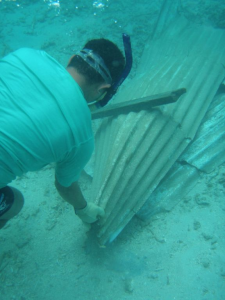
Samoa, located in the Pacific Ocean near Australia and New Zealand, is made up of two main islands, Savai’i and Upolu, and several smaller islands. The islands are home to about 200,000 Samoans of Polynesian decent, most of whom reside in indigenous villages of 200-500 people.
In September 2009, an 8.1 magnitude earthquake triggered 2 smaller 7.8 magnitude earthquakes within minutes of each other. This unprecedented pattern of quakes then triggered a tsunami that reached a wave height of about 14 meters, or about 46 feet, above sea level when it reached Samoa. Nearly 200 people were killed on these small islands, and several villages were completely washed away.

In 2010, Global Greengrants awarded Aleipata Marine Protected Area Society a $15,000 grant to conduct cleanup activities in the Aleipata area of Upolu Island. Working with representatives from the villages, debris such as roofing irons, automobiles, and timber were removed from 11 district villages and coastal areas.
Aleipata Marine Protected Area Society also planted mangrove seedlings in areas where mangroves were destroyed, with the help of the indigenous communities. The new mangroves will reduce the further environmental destruction through erosion.
Thanks to a small grant provided by generous donors, many indigenous Samoans are able to rebuild their communities in the wake of a terrible disaster.
